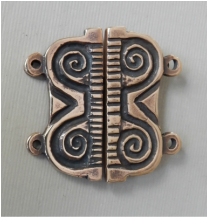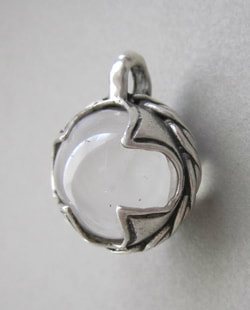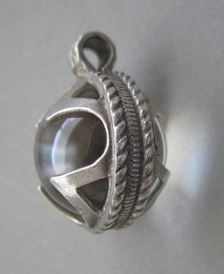VIKING PIECES
To shop now go to https://masterarks.etsy.com
CUP BROOCHES
One of the most characteristic items of female Viking jewelry are the pairs of Oval Brooches, sometimes called Tortoise Brooches or Cup Brooches, from their shape. They are found in many female graves from the Viking Age. The brooches were sometimes connected with chains or strands of beads of glass, silver, amber or jet. Viking brooches were used as clothes fasteners and worn as an ostentatious display of wealth. These Viking brooches take a variety of different forms incorporating dragons and mythical beasts into intricate knotwork designs.
One of the most characteristic items of female Viking jewelry are the pairs of Oval Brooches, sometimes called Tortoise Brooches or Cup Brooches, from their shape. They are found in many female graves from the Viking Age. The brooches were sometimes connected with chains or strands of beads of glass, silver, amber or jet. Viking brooches were used as clothes fasteners and worn as an ostentatious display of wealth. These Viking brooches take a variety of different forms incorporating dragons and mythical beasts into intricate knotwork designs.
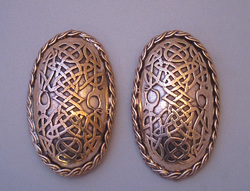
LARGE VIKING CUP BROOCHES
This pair is my own original design, inspired by historic pieces.
Each of these brooches has a hand made pin at the back. They are cast in bronze and are very solid and sturdy. These brooches are a large 11 cm by 6 1/2 cm. T
This pair is my own original design, inspired by historic pieces.
Each of these brooches has a hand made pin at the back. They are cast in bronze and are very solid and sturdy. These brooches are a large 11 cm by 6 1/2 cm. T
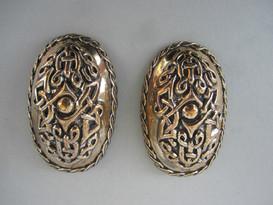
VIKING CUP BROOCHES
These sturdy bronze cup brooches weigh 4 ounces each and have a strong handmade pin on the back. They are high domed and deeply carved. These brooches are 8 1/2 cm by 5 cm and are 2 cm high.
These sturdy bronze cup brooches weigh 4 ounces each and have a strong handmade pin on the back. They are high domed and deeply carved. These brooches are 8 1/2 cm by 5 cm and are 2 cm high.
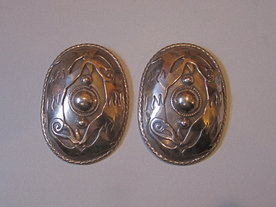
WOLF CUP BROOCHES
This pair is my own original design, inspired by historic pieces, and incorporates Fenris, the wolf, in the design.
Each of these brooches has a hand made pin at the back. They are cast in bronze and are very solid and sturdy. These brooches are 8cm X 5 3/4 cm.
This pair is my own original design, inspired by historic pieces, and incorporates Fenris, the wolf, in the design.
Each of these brooches has a hand made pin at the back. They are cast in bronze and are very solid and sturdy. These brooches are 8cm X 5 3/4 cm.
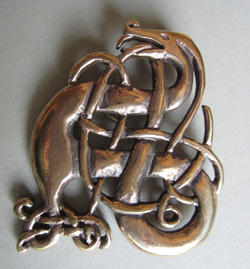
URNES BEAST
The Urnes style combines thick and thin elements in an interlacing pattern and often features fantastical beasts. I carved the original for this piece out of elk antler and have cast it in bronze. It measures the same as a similar original Viking piece, being 5 1/2 by 5 cm. I make it as a pendant or as a brooch.
The Urnes style combines thick and thin elements in an interlacing pattern and often features fantastical beasts. I carved the original for this piece out of elk antler and have cast it in bronze. It measures the same as a similar original Viking piece, being 5 1/2 by 5 cm. I make it as a pendant or as a brooch.
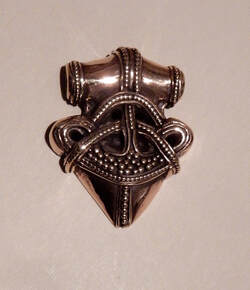
VIKING PENDANT
This granulated Viking pendant was inspired by a 10th century gold pendant found in Sigtuna, Uppland, Sweden and currently on display in the Swedish History Museum.
My cast bronze pendant is about twice the size of the original at 5.2 cm long and 2.2 cm wide. It is a heavy pendant at 2 ounces in weight.
It has large 5 mm holes in the sides so it can be put on a chain or cord or strung on a strand of beads.
This granulated Viking pendant was inspired by a 10th century gold pendant found in Sigtuna, Uppland, Sweden and currently on display in the Swedish History Museum.
My cast bronze pendant is about twice the size of the original at 5.2 cm long and 2.2 cm wide. It is a heavy pendant at 2 ounces in weight.
It has large 5 mm holes in the sides so it can be put on a chain or cord or strung on a strand of beads.
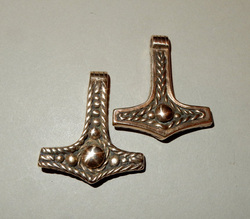
THOR'S HAMMER
Thor's hammers were popular amulets during the Viking Age. Thor, the god of thunder, had a magical hammer called Mjollnir. He used this hammer to protect both gods and mortals. Hence the Thor's hammer was worn as a talisman of protection, as well as by followers of Thor. Thor's hammers have been found in Anglo Saxon burials as well as viking sites.
While many Thor's hammers that are offered for sale are replicas of old pieces, Master Ark's Thor's hammer is his own original design. It is reversible. Both sides are shown. It is 4 cm by 3 1/2 cm with a hole of just under 3 mm for a cord. It is cast bronze and weights 25 grams.
Thor's hammers were popular amulets during the Viking Age. Thor, the god of thunder, had a magical hammer called Mjollnir. He used this hammer to protect both gods and mortals. Hence the Thor's hammer was worn as a talisman of protection, as well as by followers of Thor. Thor's hammers have been found in Anglo Saxon burials as well as viking sites.
While many Thor's hammers that are offered for sale are replicas of old pieces, Master Ark's Thor's hammer is his own original design. It is reversible. Both sides are shown. It is 4 cm by 3 1/2 cm with a hole of just under 3 mm for a cord. It is cast bronze and weights 25 grams.
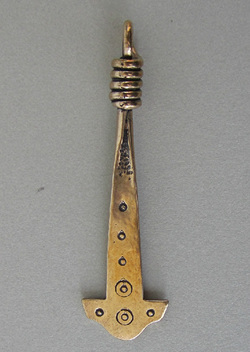
LONG HAMMER
This hammer is based on a 6 - 7th century find from Kent, England. I liked the way it was made from a flat sheet of metal that had been hammered into wire and then wrapped to make the suspension loop. I also used punch work decoration as was used on the period piece. It is 7cm long and 2 cm wide, bronze.
This hammer is based on a 6 - 7th century find from Kent, England. I liked the way it was made from a flat sheet of metal that had been hammered into wire and then wrapped to make the suspension loop. I also used punch work decoration as was used on the period piece. It is 7cm long and 2 cm wide, bronze.
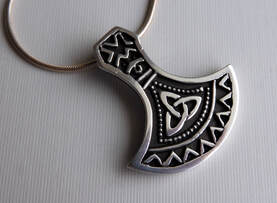
AXE PENDANT
This Viking axe head amulet was inspired by an 8th century Scandinavian pendant. A number of axe head shaped amulets have been discovered in different styles.
My pendant is about 1 1/2 inches long and just slightly less in width. It has a 3mm loop on the back for a fine chain or cord. I am making this piece in cast bronze or in Sterling silver.
This Viking axe head amulet was inspired by an 8th century Scandinavian pendant. A number of axe head shaped amulets have been discovered in different styles.
My pendant is about 1 1/2 inches long and just slightly less in width. It has a 3mm loop on the back for a fine chain or cord. I am making this piece in cast bronze or in Sterling silver.
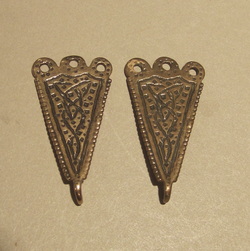
HOSE HOOKS
Called hose hooks, hooked tags, or garter hooks, these hooks are sewn on the end of leg wraps. They then hook into the body of the wrap to fasten it. Like the original they are 4cm by 2cm and have three pierced lobes for sewing the hooks on and a hook for fastening it to the leg wrap.
This pair of cast bronze hose hooks are based a pair of hooks were found by the knees of a body buried on Cathedral Green, Winchester. They are Anglo-Saxon from the second half of the ninth century.
They are sold as a pair.
Called hose hooks, hooked tags, or garter hooks, these hooks are sewn on the end of leg wraps. They then hook into the body of the wrap to fasten it. Like the original they are 4cm by 2cm and have three pierced lobes for sewing the hooks on and a hook for fastening it to the leg wrap.
This pair of cast bronze hose hooks are based a pair of hooks were found by the knees of a body buried on Cathedral Green, Winchester. They are Anglo-Saxon from the second half of the ninth century.
They are sold as a pair.
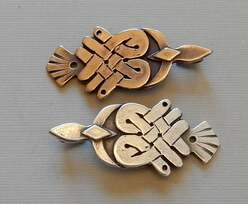
Raven Hose Hooks
Called winingas hooks, vindingr, hose hooks, hooked tags, or garter hooks, these hooks are sewn on the end of leg wraps. They then hook into the body of the wrap to fasten it. They are 4 1/2cm by 2cm and have three pierces for sewing the hooks on and a hook for fastening it to the leg wrap.
This pair of cast bronze hose hooks are based on a Viking bird brooch found at Birka and Viking vindingar finds.
They are sold as a pair.
Called winingas hooks, vindingr, hose hooks, hooked tags, or garter hooks, these hooks are sewn on the end of leg wraps. They then hook into the body of the wrap to fasten it. They are 4 1/2cm by 2cm and have three pierces for sewing the hooks on and a hook for fastening it to the leg wrap.
This pair of cast bronze hose hooks are based on a Viking bird brooch found at Birka and Viking vindingar finds.
They are sold as a pair.
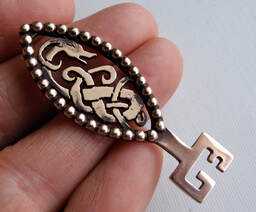
VIKING KEY
Viking keys and locks are elaborate and fascinating. Keys were also symbolic of status and position. I have created my key based on numerous Viking keys to create a key that is unique, yet retains the essence of a key from the Viking age.
My key is 2 1/4 inches long and just over 3/4 inch wide. It is cast in bronze. There is a 3 mm space at the top of the key so that it can be attached to a chatelaine or a festoon.
Viking keys and locks are elaborate and fascinating. Keys were also symbolic of status and position. I have created my key based on numerous Viking keys to create a key that is unique, yet retains the essence of a key from the Viking age.
My key is 2 1/4 inches long and just over 3/4 inch wide. It is cast in bronze. There is a 3 mm space at the top of the key so that it can be attached to a chatelaine or a festoon.
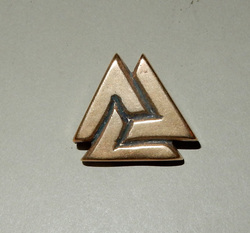
VALKNUT
The Valknut is an ancient Germanic symbol that is often associated with Odin. It has been suggested that it is a symbol for the transition from life to death and probably back again. For me it also signifies the interconnectedness of all things on all planes of existence.
This bronze Valknut pendant is 25mm across and has a large 5 mm loop on the back for a cord or chain. I carved the original for this piece out of elk antler.
Valknuts are drawn beneath the Odin's horse, Slepnir, on the 7th century Tängelgårda stone on the island of Gotland, Sweden.
The Valknut is an ancient Germanic symbol that is often associated with Odin. It has been suggested that it is a symbol for the transition from life to death and probably back again. For me it also signifies the interconnectedness of all things on all planes of existence.
This bronze Valknut pendant is 25mm across and has a large 5 mm loop on the back for a cord or chain. I carved the original for this piece out of elk antler.
Valknuts are drawn beneath the Odin's horse, Slepnir, on the 7th century Tängelgårda stone on the island of Gotland, Sweden.
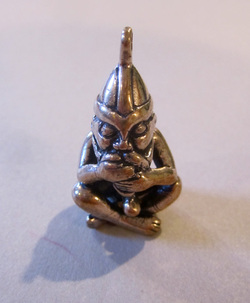
FREY PENDANT
Frey or Freyr is one of the most important Norse gods He is associated with virility, peace and prosperity, sunshine and fair weather. He is depicted as a phallic fertility god. Freyr is one of the Vanir, the twin brother of the goddess Freya. The gods gave him Alfheim, the realm of the light elves, as a teething present. He rides the shining boar Gullinbursti across the sky.
This depiction was created by my apprentice Katy Getchell and is based on the piece on display in the Swedish National Historical Museum.
This piece is a total of 31mm high, 21 mm wide, and 15 mm deep. It has a small loop on top of the helmet for a ring to attach it to a chain or for stringing onto a strand of beads.
(Please be aware that this piece has a prominent phallus.)
Frey or Freyr is one of the most important Norse gods He is associated with virility, peace and prosperity, sunshine and fair weather. He is depicted as a phallic fertility god. Freyr is one of the Vanir, the twin brother of the goddess Freya. The gods gave him Alfheim, the realm of the light elves, as a teething present. He rides the shining boar Gullinbursti across the sky.
This depiction was created by my apprentice Katy Getchell and is based on the piece on display in the Swedish National Historical Museum.
This piece is a total of 31mm high, 21 mm wide, and 15 mm deep. It has a small loop on top of the helmet for a ring to attach it to a chain or for stringing onto a strand of beads.
(Please be aware that this piece has a prominent phallus.)
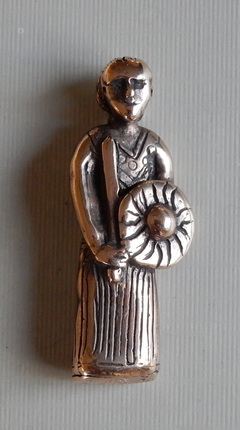
VALKYRIE
This Valkyrie figure is based on a thumb-sized figurine discovered in Denmark at Hårby on Funen by metal detectorist Morten Skovsby in 2012. It is the only 3D representation of a Valkyrie ever found.
The original figurine dates from about 800 AD. The Valkyrie is sturdily dressed, armed with a double-sided Viking sword and a round shield, her hair neatly twisted into a long ponytail forming a loop, suggesting it may have been worn as a pendant.
The Valkyries were companions of the god Odin who descend on battlefields to transport valiant slain warriors to Valhalla.
My Valkyrie is 49 mm high by 14 mm wide and weighs one ounce. There is a 2 mm hole between the neck and hair so that she can be strung on a cord or into a strand of beads.
This Valkyrie figure is based on a thumb-sized figurine discovered in Denmark at Hårby on Funen by metal detectorist Morten Skovsby in 2012. It is the only 3D representation of a Valkyrie ever found.
The original figurine dates from about 800 AD. The Valkyrie is sturdily dressed, armed with a double-sided Viking sword and a round shield, her hair neatly twisted into a long ponytail forming a loop, suggesting it may have been worn as a pendant.
The Valkyries were companions of the god Odin who descend on battlefields to transport valiant slain warriors to Valhalla.
My Valkyrie is 49 mm high by 14 mm wide and weighs one ounce. There is a 2 mm hole between the neck and hair so that she can be strung on a cord or into a strand of beads.

ODIN'S RAVEN
This raven brooch is based on several Viking ravens done in a similar style. It is cast in bronze and is 8 cm long by 2 1/2 cm wide. It has a stainless steel pin on the back.
This raven brooch is based on several Viking ravens done in a similar style. It is cast in bronze and is 8 cm long by 2 1/2 cm wide. It has a stainless steel pin on the back.
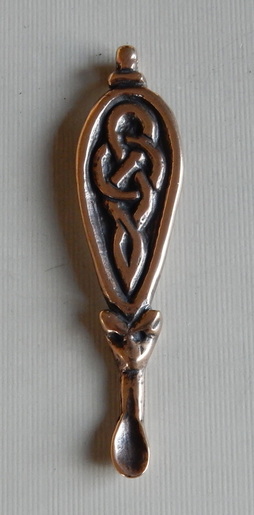
VIKING EAR SPOON
Viking ear spoons were common accessories, carried by both men and women. Viking women often wore them suspended from their brooches or chatelaines.
My cast bronze ear spoon is 65mm by 15mm and weighs about 1/2 ounce.
It has a 2mm hole through the top to hang it from.
It is based on a historic bronze ear spoon from Birka on display in the Historiska Museet, Stockholm.
Viking ear spoons were common accessories, carried by both men and women. Viking women often wore them suspended from their brooches or chatelaines.
My cast bronze ear spoon is 65mm by 15mm and weighs about 1/2 ounce.
It has a 2mm hole through the top to hang it from.
It is based on a historic bronze ear spoon from Birka on display in the Historiska Museet, Stockholm.
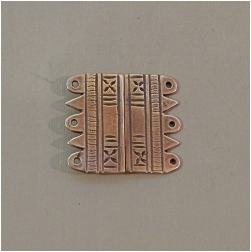
WRIST CLASPS #1
Wrist clasps or sleeve clasps were an important dress accessory for both Vikings and Anglo Saxons. Women wore the clasps at the wrist and bosom. Men may have worn them at both the wrists and the ankles. Originating in Scandinavia they came to Great Britain around 475 AD with the Vikings. They are a common grave find among Anglo Saxons.
Anglo Saxons sewed the clasps onto tablet woven bands at the cuffs. In Scandinavian they were often riveted to the clothing. Leather bands were sometimes used instead of woven bands.
My wrist clasps are based on the study of numerous period examples and are a common style. They are sized to match the original examples, the pair being about 1 1/4 inches square when fastened. Like the originals they fasten with a hook and loop. They are sturdy cast bronze.
CRYSTAL SPHERES
I do these spheres in four sizes. All are Sterling silver set with clear quartz or other natural stones.
There are several well known examples of Viking pieces done in this style, the most well known being the Gotland sphere. They have also been found in Saxon burials.
I do these spheres in four sizes. All are Sterling silver set with clear quartz or other natural stones.
There are several well known examples of Viking pieces done in this style, the most well known being the Gotland sphere. They have also been found in Saxon burials.
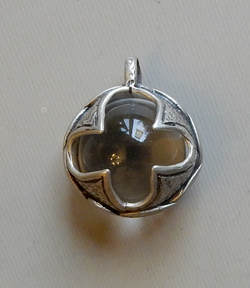
CRYSTAL SPHERE #2
This style is 22mm across and weighs 16 grams.
This style is 22mm across and weighs 16 grams.
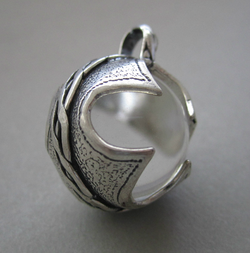
CRYSTAL SPHERE #3
This style is 24mm across and
weighs 22 grams.
This style is 24mm across and
weighs 22 grams.
I offer other gemstones in these settings. Visit my Etsy shop to see what else is currently available.
To shop now on Etsy just go to:
https://masterarks.etsy.com
https://masterarks.etsy.com
